Wasiu Agunbiade Lamidi
College of Agriculture, Ejigbo Campus, Osun State University, Osogbo, Nigeria
Correspondence to: Wasiu Agunbiade Lamidi, College of Agriculture, Ejigbo Campus, Osun State University, Osogbo, Nigeria.
| Email: |  |
Copyright © 2015 Scientific & Academic Publishing. All Rights Reserved.
Abstract
The experiment design was a randomised complete block of four treatments replicated three times each, 4× 3 factorial design. The plots were planted with an improved maize seed variety. Collected data include plant heights, number of leaves per plant, leaf length and breadth, the weed dry weight per square metre of each weeding and yield parameters like cob weights, cob lengths, cob circumferences and maize shelled weights. One way-ANOVA and descriptive statistics were used in data analysis. The results revealed that there was a significant effect (p= 0.0194, p= 0.0172), of the mechanically heaped and manually heaped methods on the maize plants- cobs’ circumference and cobs’ length. Weeds’ heights and weights were higher in the manually cleared land, sprayed once plot than all others. There were stronger relationships between the independent variables, different cultivation methods and the yields of maize with the higher R2 values of 0.76 and 1.00. Soil fertility improves via different cultivation methods as shown in maize yield. There was significant effects of mechanically heaped and manually heaped methods on the number of grains in cobs selected at random and cobs’ yield weight in tonnes/acre (p= 0.044, p= 0.012).
Keywords:
Cobs’ circumference, Cobs’ length, Plants’ heights, Students, Weed heights
Cite this paper: Wasiu Agunbiade Lamidi, Studies of Maize (zea mays) Production under Different Cultivation Methods as a Practicum for Senior Secondary School Students, International Journal of Agriculture and Forestry, Vol. 5 No. 1, 2015, pp. 38-44. doi: 10.5923/j.ijaf.20150501.06.
1. Introduction
Maize (Zea mays) sometimes referred to as corn serves as human consumption and as well as the major raw materials for livestock feed in the world and especially Nigeria ([1] and [2]). With its numerous importances in the society, maize is still faced with so many problems among which are weeds, pest and diseases and weather conditions. Many of these problems have been solved in due course [3]. Students need to be taught about all these because of future [4], especially about some ways weeds have been suppressed by researches and farmers who adopted their results. Some weedcides used in controlling weeds by farmers include Atrazine (Triazine)- pre-emergency herbicide and Primextra II magnum, many of such herbicides have shown apparent propensity to retard growth of cassava or maize shoots [5]. This has led to the research procedures formulated, carried out together with the students, and data collection, all was to be able to reach conclusion that may be useful for others.In the course of carrying out the research in the study area, several problems and setback were expected to affect the smoothness of the research task. Some of the problems include uncontrolled weed growth and this cause direct loss of yield as a result of competition with crop plants for plants for light, water and soil nutrients which could have been available for the maize plant. It reduces the quantity and the quality of maize production and which result into shortage for most of the West African farmer ([3], [6] and [7]). As a result of this, weed must be controlled on the maize plot. Different methods can be used to control weed which include mechanical, chemical, manual, cultural and biological methods.The integrated weed control system in an economic form combines aspect of two or more weed control method at low input level to keep weed competition in a given cropping system ([8] and [9]). It is one of the best options for weed control in the tropics. Examples of such weeds are Eleucine indica, Panicum maximum; Imperata cylindrical and Eupatorum odorantum. In their own study [10] opined that mechanical method of weed control starts with the clearing of land by disc plough or other means of clearing by manual or machines. Agricultural mechanisation may be defined as all forms of mechanisation assistance and process used at any level of sophistication in agricultural production to reduce human drudgery, to improve timeliness and the effectiveness of various farm operations to increase crop yield and preserve the quality of agricultural products, ([10], [11] and [7]). By contrast, biological, chemical and technical advancement like the use of seeds of high yield varieties (HYV), fertilisers, pesticides, modified tillage methods and the introduction of irrigation serve to improve land productivity ([12], [13] and [14]). Is there a significant difference in crop planted using manually cleared land and the mechanically cleared land? Do we have difference (s) in maize crops planted using only manually cleared land. Would time of planting and weeding of manually cleared land for maize be different to the mechanically cleared? It was therefore hypothesized that there were differences between the mechanically cleared and manually cleared land in the control of weeds on the maize plot and there were differences in performances of maize under these systems of controlling weeds on maize plot. The objective of the study was to investigate and teach the students of secondary school the use of mechanical and manual land clearing to control weeds for maize production.
2. Methodology
The research work was carried out at the Osun State College of Education, Ila-Orangun Farm, Ora Road, Ila-Orangun, Nigeria, it was feasible to enable the public to benefit from the project. Also, College High School is in the same neighbourhood, this allowed the students there to be used for the research. Because of the cost and the problem of land tenure system, the project was limited to the area under consideration only. The size and the dimension of the farm was a rectangular plot of 750 square metre plot of land used for the project. The plot was sub-divided into twelve plots of 10m by 5m for the four treatments replicated thrice in the study. The land was a fallow land [1] previously cultivated with cassava ten years back. It was well drained and the surface soil had fine texture of sandy loam soil. The rainfall was regular during the period of the experiment between 300 and 350 mm. The following were the common weeds found on the land before the experiment, devil weeds (Mucuna inrium); broom weed (Sida acuta); goat weed (Ageratum conyzoldes); sun flower (Africana aspilia) and spear grass (Imperata cylindrica).The experiment design used was randomised complete block with four treatments replicated three times each, this makes it 4 x 3 factorial. All the 30 students designated for the project fully participated, this was to allow them to know and to be able to carry out the experiment on their own and to teach nearby farmers. The treatments were labelled as follows:MNS - manually heaped plot, weed free, sprayed once with herbicides after maize planting.MCS - mechanically heaped plot, weed free, ploughed twice, sprayed once with herbicides after maize plantingMCW - mechanically heaped plot, plough once, weeding once 6 weeks after maize planting, no sprayingMC - mechanically heaped plot, zero weeding, no spray with herbicidesThree sub plots were cleared manually to form the three replicates of the manually cleared land weed free while the remaining nine plots were cleared mechanically for the other three treatments. The plots were then planted with an improved maize seed variety on the 17th June 2012 using plant population of 40,000/ha; supplying was done in a week after planting and whole plots were done according to the treatment of plant per stand. Weeding was done according to the treatments and procedures, and other cultural operation like fertilising with NPK 15-15-15 was done at the rate of 50 kg per acre. The number of specimen used for each of the research variables per treatment was n = 50 except where only longest or shortest, highest or lowest were used per replicate per treatment. Data were collected on plant heights, weeds’ densities, number of leaves per plant, leaf lengths and leaf breadths. Also, data were collected on fresh weights of weeds per acre at each weeding and cob weights, cob lengths, cob circumferences of 50 cobs selected at random and maize shelled weights or yield of maize. Cost of land, labour, seeds and other inputs were common to all the plots and were not analysed in the research. One way-ANOVA was used in data analysis for heights of weeds, circumferences of the cobs and yield of cobs and their lengths. Descriptive statistics was also used for the heights of the maize, densities and heights of weeds and number of cobs per plot.
3. Results and Discussion
Because of their tenderness at 4 and 6 weeks of planting, many plants had their heights measured, out of which the longest and the shortest leaves were recorded. Each of the results show highest and shortest maize heights per replicate and are separated by comma. Table 1 revealed that maize grown on mechanically cleared land, weed free (MCS) range from 28-32 cm given the highest mean of 31.7±0.6 cm while that of manually cleared land, weed free range from 28-32 cm given a mean of 31.0±1.0 cm. This difference may be due to the fact that in mechanically cleared land, weed free plot was ploughed twice which made it possible for the roots of the maize plant to penetrate fully into the soil and make effective use of the available nutrients unlike in manually cleared land, weed free (MNS) where after clearing once, the soil clods were not broken and planting was done immediately, maize plants’ roots could not efficiently use the soil nutrients.Table 1. Maize plant heights (cm) at 4th week and 6th week after planting, cm, (n = 2 per replicate)
 |
| |
|
Table 1 also showed the data on plant height at six weeks after planting. The data recorded for maize grown on manually cleared land, weed free (MNS) ranges from 54 - 64 cm with mean 61.0±2.7 cm and those on mechanically cleared land, weed free (MCS) range from 66 - 74 cm with the mean of 71.7±2.5 cm, highest, while that of mechanically cleared land, weeded 8 weeks after planting range from 65 - 73cm. The differences were due to the fact that mechanically cleared land, for planting and weeding was ploughed twice; this made it possible for contact between maize roots and soil which is very important for the transfer of water and nutrients in solution from the soil to the plant very well established. An effective use of the available nutrients was made unlike in manually cleared land, weed free- MNS as they have high plants’ heights. Weeding seemingly had effects on the maize plot in MCW. Figure 1 revealed the data on weeds’ densities at eight weeks after planting. The plotted values were the weeds’ densities recorded for maize in the different plots at the time of recording. Mechanically cultivated, heaped plot, weed free, sprayed once with herbicides after maize planting - MCS had the highest as shown followed by MNS. In mechanically cleared land, zero weeding- MC, heights were low because the plots were not weeded and weeds competed with maize.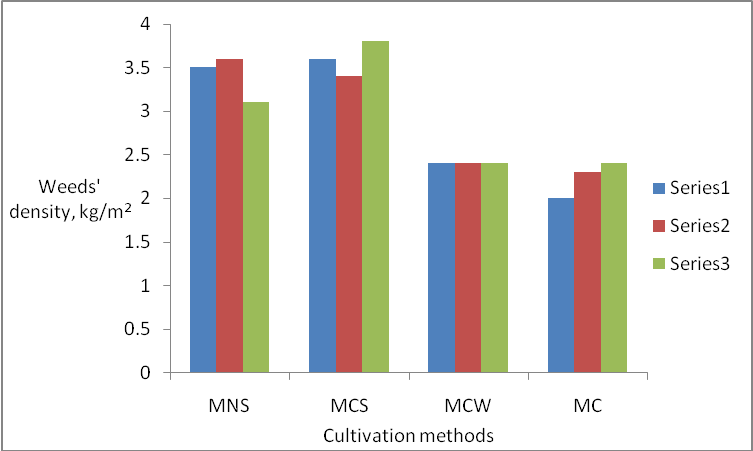 | Figure 1. Highest Weeds’ density at 8 weeks after planting –kg/m2 |
In Figure 1, manually cleared land, weed free ranges in densities from 3.1 – 3.6 kg/m2 with mean 3.4 kg/m2 and those on mechanically cleared land, weed free range from 2.3 – 2.4 kg/m2 with the mean of 2.3 kg/m2, 47.8% less in MCW than MC. Series 1,2 and 3 are respectively for Replicates 1, 2 and 3. They were good for planting and weeding because of their ploughed twice which made it possible for the roots of the maize plant to penetrate fully the topsoil and subsoil to make effective use of the available nutrients. The mechanically cleared land, zero weeding, range was 3.4 – 3.8 kg/m2, with a mean of 3.6 kg/m2, with a percentage 56.5% higher in MC than MCW. The differences were much and were due to the fact that mechanically cleared land, for planting and weeding was ploughed twice. The mechanically cleared land, zero weeding, MC was higher in value because the plot was not weed at all. MCS had highest weed density per square metre.At 8th week, in Figure 2, manually cleared land, weed free, MNS had low weeds’ heights of 12.2 and 13 cm and those on mechanically cleared land, weed free, MCW had lowest weeds’ heights of 12 and 12.3 cm. Like in Figure 1, series 1,2 and 3 are respectively for Replicates 1, 2 and 3.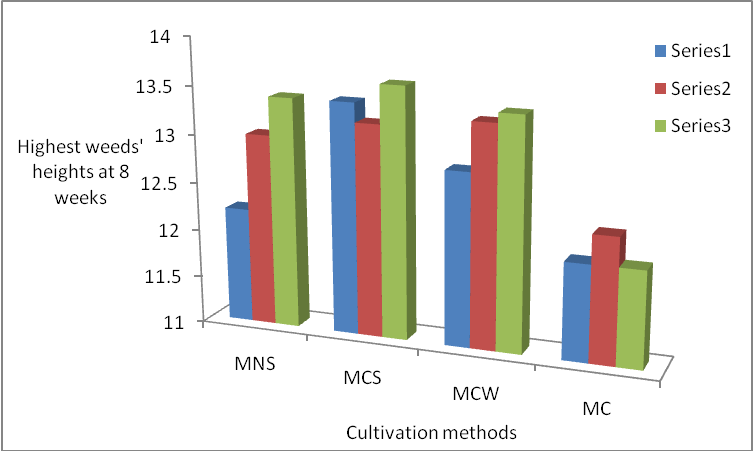 | Figure 2. Average Weeds’ highest heights at some points in different plots, cm at 8 weeks |
In Figure 3, manually cleared land, weed free, MNS had highest weeds’ weights of range 132 and 136 kg/acre and those on mechanically cleared land, weed free, MCW had lowest weeds’ weights of range 120 and 123 kg/acre. Thus, Figures 2 and 3 were complementary; the highest weeds’ heights gave rise to highest weeds’ weights when the weeds were collected. The differences were much and were due to the fact that mechanically cleared land, for planting and weeding, MCW was ploughed twice and had lesser weeds’ heights and weeds’ weights. The manually cleared land, sprayed once plot, MNS was higher in weeds’ heights, weeds’ densities and weights, because the plot was not weeded at all. Mechanically cultivation of land with appropriate weeding or spraying had lowest weeds’ heights and weights, signifying its lowest weeds’ density as well because of its reduced weights at collection.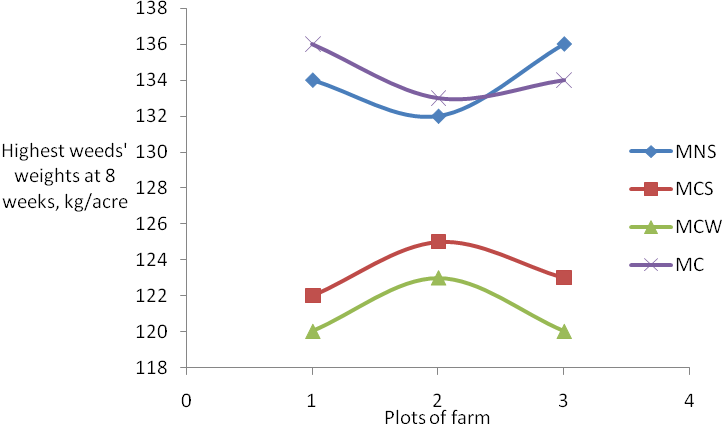 | Figure 3. Total fresh weed weights, kg/acre at 8 weeks |
Figure 3 revealed the stronger relationships between the treatments and the weeds’ weights when fresh. In all the R2 values were 0.99 and the individual treatments revealing lower kilogrammes/acre per plot may testifies to the fact that each of the treatment is worthwhile in crop production or may be due to other factors like soil nature, environmental condition and time of the year. The regression equations are as shown below: Table 2 shows the data on mean of number of cobs per stand in the treatments. The data recorded for maize grown on manually cleared land, weed free ranges from 1.2 – 1.3 with mean 1.3 and those on mechanically cleared land, weed free range from 1.5- 1.6 cm with the mean of 1.6; this was 23.1% of MCS over MNS. The mechanically cleared land, 6 weeks after planting and weeding range from 1.5 – 1.6 with a mean of 1.5, this was 15.4% of MCW over MNS. The mechanically cleared land was indeed higher, zero weeding had no range. The higher ranges in the MCW may reveal that some maize stands apparently have more than two maize cobs per stand.
Table 2 shows the data on mean of number of cobs per stand in the treatments. The data recorded for maize grown on manually cleared land, weed free ranges from 1.2 – 1.3 with mean 1.3 and those on mechanically cleared land, weed free range from 1.5- 1.6 cm with the mean of 1.6; this was 23.1% of MCS over MNS. The mechanically cleared land, 6 weeks after planting and weeding range from 1.5 – 1.6 with a mean of 1.5, this was 15.4% of MCW over MNS. The mechanically cleared land was indeed higher, zero weeding had no range. The higher ranges in the MCW may reveal that some maize stands apparently have more than two maize cobs per stand.Table 2. Mean of number of cobs per stand (n = 1 per replicate)
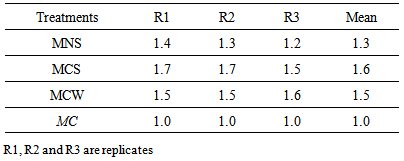 |
| |
|
This could be so because of the soil fertility improvements as the cultivation methods variations have different effects on the soil for the maize crops’ heights, weed density, crop’s overall performance and yield. The plot of MC was not weeded at any point nor spray with weedicides, it may be surmised that the number of cobs per maize stand revealed that weeds competed with maize a lot, this led to why it gave lowest number of cobs of 1 cob per stand. Some maize stands, 16 stands in MC plot, did not even produce any cob as a result of poor soil conditions in mechanically cleared land, zero weeding plot.Table 3 showed both the mean values of highest values recorded for the biggest cobs’ circumference of maize and their cobs’ length in cm in the treatment after harvesting. The results revealed that there was a significant effect of the mechanically heaped and manually heaped methods on the cobs’ circumference and cobs’ length (p= 0.0194, p= 0.0172). The mean values show statistical differences between the treatments and the highest values for the biggest cobs’ circumference of maize and their cobs’ length recorded in the research. Thus in general, the treatments broadly speaking, mechanically and manually heaped, whether weeded or sprayed with weedcides, have significant effect (p = 0.05) on the yield in term of cobs’ circumference and length and number of cobs produced per stand. Table 3. Mean values of Cobs’ circumference (±STDEV) of maize per stand in cm (n = 50 per replicate)
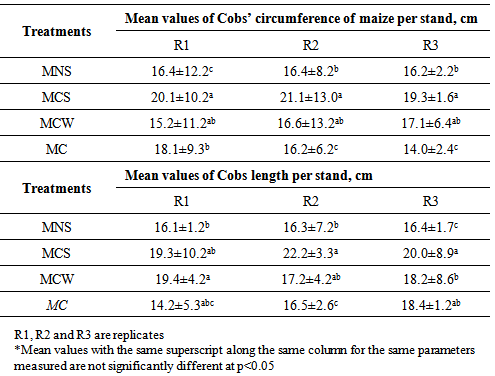 |
| |
|
Figure 4 revealed the differences and similarities between percent maize stands on different plots of farm at eight weeks after planting. Mechanically cultivated, heaped plot, weed free, sprayed once with herbicides after maize planting – MCS and mechanically cleared land, zero weeding, MC had highest percent maize stands on the average, 26.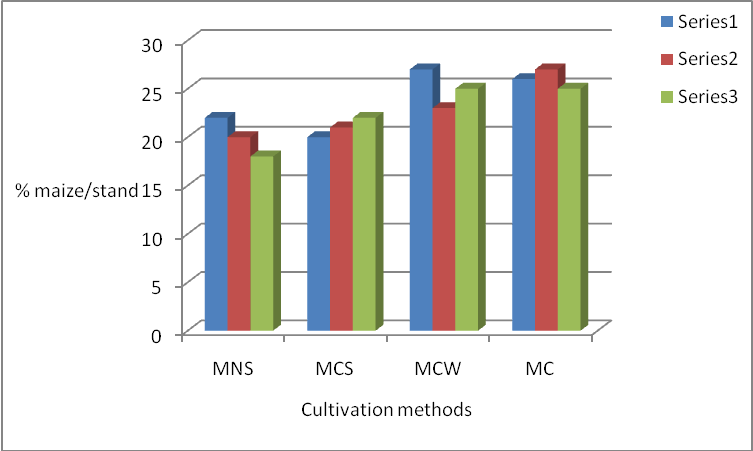 | Figure 4. Percentage of maize per stand % |
Table 4 shows both the mean values of number of grains per 50 cobs selected at random/plot and Cobs’ Yield Weight -tonnes/ acre in the treatments after harvesting. The results revealed that there was a significant effect of the treatments; mechanically heaped and manually heaped methods on the mean of number of grains of 50 cobs selected at random and cobs’ yield weight in tonnes/acre (p= 0.044, p= 0.012). The mean values show statistical differences between the treatments and the number of grains and their cobs’ yield weight recorded in the research. The difference between these mechanically heaped and manually heaped treatments is that maize crops were able to firmly hold to the soil in the mechanical clearing than manual because the land was so loose, even some of the crops’ spot on the soil were so loose that crops were falling down and were quickly re-erected to deter animal pests from consuming them. Table 4. Mean values of number of grains per 50 cobs selected at random/plot and Cobs’ Yield Weight - tonnes/ acre
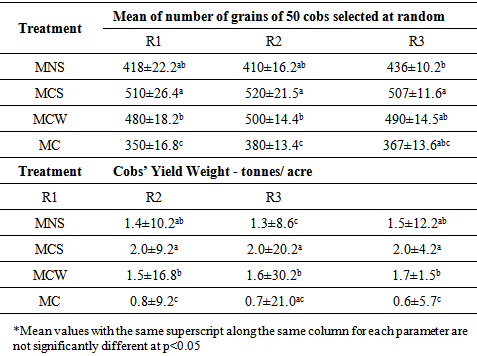 |
| |
|
4. Conclusions
The following conclusions were arrived at in the course of the research:1. There was a significant effect of the mechanically heaped and manually heaped methods on the maize plants-cobs’ circumference and cobs’ length. Mechanically and manually heaped, whether weeded or sprayed with weedcides, have significant effect (p = 0.05) on the yield in term of cobs’ circumference and length and number of cobs produced.2. There was a significant effect of mechanically heaped and manually heaped methods on the number of grains of cobs selected at random and cobs’ yield weight in tonnes/acre.3. There were stronger relationships between the independent variables, different cultivation methods and the yields of maize with the higher values of R2 values. 4. Soil fertility improves via different cultivation methods as shown in maize yield. 5. Manually cleared land, sprayed once plot, MNS was higher in weeds’ heights and weeds’ weights, because the plot was not weeded at all.6. Different soil cultivation methods are very important for the transfer of water and nutrients in solution from the soil to the plant. 7. The students learnt how different cultivation systems were able to suppressed weeds in their different plots.8. Students were able to learn a lot from the project since the whole research was a practicum and they carried it out on their own with little assistance.
ACKNOWLEDGEMENTS
The students of the Departments of Agricultural Education, Osun State College of Education, Ila-Orangun, and students of Senior Secondary School II of College High School, Ila-Orangun, Osun State of Nigeria are highly appreciated for their efforts in making sure that the research was carried out as planned. Also the management team of Osun State College of Education, Ila-Orangun are appreciated.
References
| [1] | FAO, (2012). www.fao.org Assessed December 11, 2012 and March 3, 2013. |
| [2] | Obi, I. U. (1991). Maize, its Agronomy, Disease, Pests and Food Values, Enugu: Computer Optimal Solutions Ltd. |
| [3] | International Institute of Tropical Agriculture (IITA), (2008). Increasing Maize Production in West Africa. www.iita.org/maize-asset/-/. |
| [4] | International Food Policy Research Institute (IFPRI), (2004). Assuring Food and Nutrition Security in Africa by 2020. Proceedings of an All-African Conference (Ed:Ketema S.). IFPRI 2020 version, April 1-3, 2004 Kampala, Uganda. |
| [5] | Alderelm Ltd Sales Terms, (2010). Working and Growing together, Chemicals for Agriculture. Lagos, Nigeria. Assessed 12/04/2014. |
| [6] | Food and Agricultural Organisation (FAO), (2003). World Agricultural Reports, Bulletin news Assessed 10/02/2013. |
| [7] | FAO, (1986). Food and Agricultural Organisation; Agricultural Mechanisation is Development. Guidelines for strategy formulation, Agricultural services Bulletin 55. |
| [8] | Olabode, O. S., Adesina, G.O & Olapeju, T. R. (2011). A survey of Agricultural Chemical available to farmers in South Western Nigeria. International Journal of Agricultural Economics & Rural Development, 4(1), 2011, 12-18. |
| [9] | MoE.BC (Ministry of Environment, British Columbia), (2006). British Columbia Crop Production Guides. http://www.agf.gov.bc.ca/pesticides/a Assessed 15/04/2013. |
| [10] | Lamidi, W. A. & Akande, L. O. (2013). A Study of status, challeges and prospects of Agricultural Mechanisation in Osun State of Nigeria. Journal of Education, Arts and Humanities, 1 (1), 001-008.http://www.watchpub/jeah/index.htm. |
| [11] | Lamidi, W. A., (1998). Reporst of study Tour on Food and Agro-Processing and Rural Development in India and Indonesia, March-April, 1998, sponsored by Federal Government of Nigeria/ UNDP/ILO. |
| [12] | FAO, (2008). Food and Agricultural Organisation; Guidelines for strategy formulation, Agricultural services Assessed 10/03/2013. |
| [13] | FAO, (2007). Food and Agricultural Organisation; Guidelines for strategy formulation, Agricultural services Assessed 10/02/2013. |
| [14] | Anthony Y. A., (1980). Soil Preparation and Weed Control in the tropics, Rainbow Publishers, Ibadan. |




 Table 2 shows the data on mean of number of cobs per stand in the treatments. The data recorded for maize grown on manually cleared land, weed free ranges from 1.2 – 1.3 with mean 1.3 and those on mechanically cleared land, weed free range from 1.5- 1.6 cm with the mean of 1.6; this was 23.1% of MCS over MNS. The mechanically cleared land, 6 weeks after planting and weeding range from 1.5 – 1.6 with a mean of 1.5, this was 15.4% of MCW over MNS. The mechanically cleared land was indeed higher, zero weeding had no range. The higher ranges in the MCW may reveal that some maize stands apparently have more than two maize cobs per stand.
Table 2 shows the data on mean of number of cobs per stand in the treatments. The data recorded for maize grown on manually cleared land, weed free ranges from 1.2 – 1.3 with mean 1.3 and those on mechanically cleared land, weed free range from 1.5- 1.6 cm with the mean of 1.6; this was 23.1% of MCS over MNS. The mechanically cleared land, 6 weeks after planting and weeding range from 1.5 – 1.6 with a mean of 1.5, this was 15.4% of MCW over MNS. The mechanically cleared land was indeed higher, zero weeding had no range. The higher ranges in the MCW may reveal that some maize stands apparently have more than two maize cobs per stand.
 Abstract
Abstract Reference
Reference Full-Text PDF
Full-Text PDF Full-text HTML
Full-text HTML


